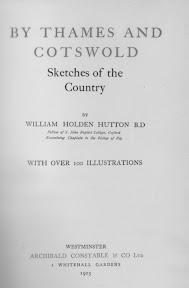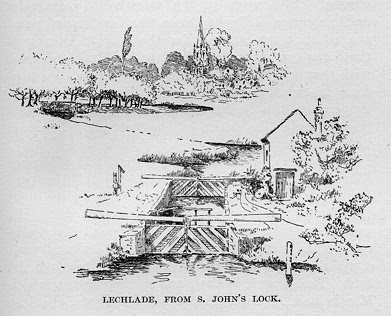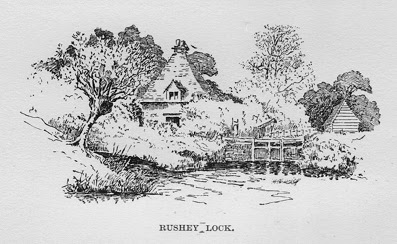Many thanks to Andrew Denny of Granny Buttons for the warm comments on my last blog.
When I looked at the comments left on Granny's site I noticed that a reader had left a comment about Bonthron's My Holidays on Inland Waterways first published in 1916. They had just obtained a copy of the third edition at last year's IWA National. My copy is also a third edition; that edition was published in 1919. There are obvious similarities between the Lloyd's Through England's Waterways and Bonthron's earlier book and this set me thinking.
I then realised that there are in fact two pairs of books here, Thurston & Bonthron and Rolt & Lloyd, and that they have interesting parallels.
In 1911 E Temple Thurston wrote about a voyage on a narrow boat that he hired (Flower of Gloster). Five years later, in 1916, Bonthron wrote about his motor boat (launch) holidays. At that time the canals were still relatively active and both authors travelled along the now closed Thames & Severn Canal. The Flower of Gloster has beautiful illustrations but My Holidays has photographs. Flower of Gloster continued to be reprinted until the 1980s but My Holidays did not.
In 1939 Rolt travelled in his converted narrow boat(Cressy) and changed the face of British canals when he wrote Narrow Boat. This was followed five years later by the journeys described by the Lloyds in Through Englands Waterways. Both the Lloyds, and more famously the Rolts, had great difficulties dealing with a waterways system that was in decay. Narrow Boat has the evocative illustrations of Denys Watkins-Pitchford but My Holidays has photographs. Narrow Boat is still in print and will probably continue to be so for many years, but Through England's Waterways is definately out of print.
Now I know it is dangerous to read too much into coincidences, but for me these four books together provide a fascinating insight into the waterways system at key moments in the last century with the less popular books by Bonthron & Lloyd providing the enthusiast with a complementary view to the much more famous books.
Established in 2005: Blog of Steve & Maggie Parkin's 60ft narrowboat based on the Grand Union Canal; includes Steve's reviews of old waterways books
Through England's Waterways by Montague & Ann Lloyd
I suppose it's natural that since winter is here, and we don't live aboard, that our blog will be less about boat trips and more about other matters. That's why our last entry was about an old waterways book.
You might have guessed that I am very keen on second hand waterways books, particularly those that are either old or deal with aspects of canal history. I have a decent collection of the Hadfield's histories, three versions of Rolt's Narrow Boat, a first edition of the Flower of Gloster, and a 1928 copy of Bradshaws which was a 60th birthday present. So it was with some interest that I found a waterways book that I was not familiar with that was for sale on Ebay. However, I did notice that it merited a short entry in Jim Shead's list of waterways books. I was delighted when I won it with the only bid in the auction for around £5.
Through England's Waterways was published in 1948 by Imray, Laurie, Norrie & Wilson who are now famous for producing waterway maps and guides. The book is a first edition. A slim hardback with illustrations, it has a handy slip-in map of the waterways system. The map is a very useful addition to the book which I wish some modern waterways books would follow - it can also double as a handy book mark. Can you imagine reading Terry Darlington's Narrow Dog if it had a slip-in map of the European canals?
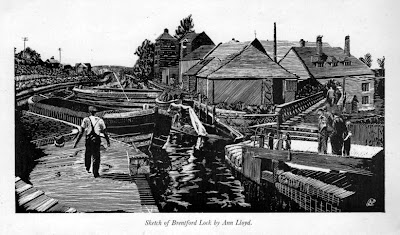
So what is Through England's Waterways all about? The book reports travels of the Lloyd family in 1946. It is essentially before Rolt's Narrow Boat, since that had barely been published. Because WWII had just finished the book is full of stories of rationing restrictions and shortages. Yet through this the Lloyds managed to complete an epic series of journeys along rivers and canals that would be a difficult task for keen boaters even today. Montague Lloyd, his daughter Krithia and his daughter-in-law Ann managed to boat along, the Kennet & Avon canal, the River Severn tidal section to Sharpness, the Sharpness Canal, the Severn to Worcester, the Worcester & Birmingham Canal, the Grand Union, the Oxford Canal, the whole of the Thames from Lechlade to Brentford, the Grand Union to Trent Junction, the Trent and Yorkshire canals, the Leeds & Liverpool canal, the Bridgwater canal, the Shropshire Union, the Staffordshire & Worcester Canal, the Grand Union to Braunston, and then took the Oxford Canal back to their Thames base at Wargrave. What an epic! Even their Kennet & Avon trip itself was ground breaking given the state of the canal; they met John Gould near Woolhampton who assist them greatly.
So what boat did they use? They actually owned three boats, a Thames cabin cruiser which they used very little, a canoe, and a 29ft mahogany slipper-sterned launch which was used for most of their journeys. She was powered by a Morris Navigator petrol engine and on several occasions they struggled to find fuel. They sometimes slept ashore but often slept under a canvas awning over the boat. They cooked by camp fire on the bank. Their launch, "Silver Stream", had the advantage of having a low air draught (she could get under some fixed swing bridges) and had a shallow (water) draught.

They had very little information to plan their route, they couldn't get hold of an old copy of Bradshaws. This is somewhat ironic given that the publisher of book was Imray. They often found navigations were closed and locks padlocked. Their trip along the K&A required negotiation with the Great Western Railway and on other occasions they were told by officials that they could not use a particular canal but they went ahead anyway.
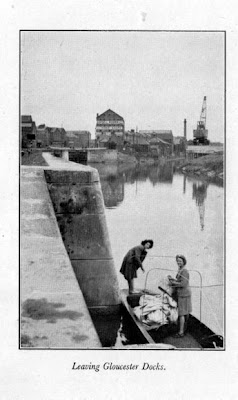
The trip up the tidal Severn from Bristol to Sharpness in their river launch (with a pilot) was hair-raising, particularly since they didn't have a functioning anchor and the engine was not totally reliable! They met many working boats and their crews, particularly in the Midlands and got on well with them. However their launch did sink on what they called the Berkeley Canal when a barge towed by a tug came around a bend at excessive speed and hit them whilst they were sheltering against the bank! The canal company paid for the repairs. And this wasn't the only time their launch sank. They also managed to damage its propeller regularly, once on a lock cill in Leicester.

Because this is only a short book of some 117 pages, there are few details and there are some errors in the text. Some locks and aqueducts are misplaced, and even some locations mis-named. The book's great strength comes from the narrative which gives you a real sense of their adventure and their incredible drive to cover much of what we now call "The System" in one summer - Montague's "crew", as he called them, were very keen. By the way, the summer was particularly wet and yet some canal companies claimed water shortages as a reason for refusing them passage. The last chapter will leave you in no doubt that you are reading a book that is out of the ordinary. It also helps explain the writing style and the inaccuracies, but I won't give the game away.
It certainly has been the best £5 I have ever spent on a second-hand waterways book and I am not talking about its resale value; I notice that the only copy currently on Abebooks is priced at £25!
Steve Parkin, November 2007
You might have guessed that I am very keen on second hand waterways books, particularly those that are either old or deal with aspects of canal history. I have a decent collection of the Hadfield's histories, three versions of Rolt's Narrow Boat, a first edition of the Flower of Gloster, and a 1928 copy of Bradshaws which was a 60th birthday present. So it was with some interest that I found a waterways book that I was not familiar with that was for sale on Ebay. However, I did notice that it merited a short entry in Jim Shead's list of waterways books. I was delighted when I won it with the only bid in the auction for around £5.
Through England's Waterways was published in 1948 by Imray, Laurie, Norrie & Wilson who are now famous for producing waterway maps and guides. The book is a first edition. A slim hardback with illustrations, it has a handy slip-in map of the waterways system. The map is a very useful addition to the book which I wish some modern waterways books would follow - it can also double as a handy book mark. Can you imagine reading Terry Darlington's Narrow Dog if it had a slip-in map of the European canals?

So what is Through England's Waterways all about? The book reports travels of the Lloyd family in 1946. It is essentially before Rolt's Narrow Boat, since that had barely been published. Because WWII had just finished the book is full of stories of rationing restrictions and shortages. Yet through this the Lloyds managed to complete an epic series of journeys along rivers and canals that would be a difficult task for keen boaters even today. Montague Lloyd, his daughter Krithia and his daughter-in-law Ann managed to boat along, the Kennet & Avon canal, the River Severn tidal section to Sharpness, the Sharpness Canal, the Severn to Worcester, the Worcester & Birmingham Canal, the Grand Union, the Oxford Canal, the whole of the Thames from Lechlade to Brentford, the Grand Union to Trent Junction, the Trent and Yorkshire canals, the Leeds & Liverpool canal, the Bridgwater canal, the Shropshire Union, the Staffordshire & Worcester Canal, the Grand Union to Braunston, and then took the Oxford Canal back to their Thames base at Wargrave. What an epic! Even their Kennet & Avon trip itself was ground breaking given the state of the canal; they met John Gould near Woolhampton who assist them greatly.
So what boat did they use? They actually owned three boats, a Thames cabin cruiser which they used very little, a canoe, and a 29ft mahogany slipper-sterned launch which was used for most of their journeys. She was powered by a Morris Navigator petrol engine and on several occasions they struggled to find fuel. They sometimes slept ashore but often slept under a canvas awning over the boat. They cooked by camp fire on the bank. Their launch, "Silver Stream", had the advantage of having a low air draught (she could get under some fixed swing bridges) and had a shallow (water) draught.

They had very little information to plan their route, they couldn't get hold of an old copy of Bradshaws. This is somewhat ironic given that the publisher of book was Imray. They often found navigations were closed and locks padlocked. Their trip along the K&A required negotiation with the Great Western Railway and on other occasions they were told by officials that they could not use a particular canal but they went ahead anyway.

The trip up the tidal Severn from Bristol to Sharpness in their river launch (with a pilot) was hair-raising, particularly since they didn't have a functioning anchor and the engine was not totally reliable! They met many working boats and their crews, particularly in the Midlands and got on well with them. However their launch did sink on what they called the Berkeley Canal when a barge towed by a tug came around a bend at excessive speed and hit them whilst they were sheltering against the bank! The canal company paid for the repairs. And this wasn't the only time their launch sank. They also managed to damage its propeller regularly, once on a lock cill in Leicester.

Because this is only a short book of some 117 pages, there are few details and there are some errors in the text. Some locks and aqueducts are misplaced, and even some locations mis-named. The book's great strength comes from the narrative which gives you a real sense of their adventure and their incredible drive to cover much of what we now call "The System" in one summer - Montague's "crew", as he called them, were very keen. By the way, the summer was particularly wet and yet some canal companies claimed water shortages as a reason for refusing them passage. The last chapter will leave you in no doubt that you are reading a book that is out of the ordinary. It also helps explain the writing style and the inaccuracies, but I won't give the game away.
It certainly has been the best £5 I have ever spent on a second-hand waterways book and I am not talking about its resale value; I notice that the only copy currently on Abebooks is priced at £25!
Steve Parkin, November 2007
By Thames & Cotswold by W.H. Hutton
During our trip along the Upper Thames we stopped at Lechlade and Steve bought a copy of "By Thames & Cotswold" by William Holden Hutton in a second-hand bookshop. The 1903 first edition turned out to be a little treasure. Although not strictly a "boating book", it covers most of villages and towns of central England including Stratford-upon-Avon, Chipping Camden & Burford, it does have some excellent descriptions of the Upper Thames from around century ago.
Frontispiece
W.H. Hutton was a "man of the cloth" who was not only interested in poetry, but was an accomplished illustrator. The book has hand-cut pages and contains nearly 100 illustration, all by the author.
Of particular interest to us were the sections dealing with Kelmscott. Hutton describes Kelmscott Manor and explains that how William Morris and Dante Gabriel Rossetti lived in the house and describes how Mrs Morris (Jane Burden) was still living there in the early 1900s. The author also describes how William Morris is buried in St George's churchyard and quotes extensively from Morris and his News From Nowhere.
As with lots of second-hand books, our copy has annotations (in pencil). It also contains a newspaper cutting from 1930 describing the charms of the village of Kelmscott and its connections with William Morris.
A particularly interesting illustration is contained in the last chapter (titled Envoy) where there is a small illustration which shows a narrow boat (Derry) being unloaded by a wheelbarrow. There is no explanation of the illustration. We particularly like the small figure fishing from the stern; is it a child?
Copies of the book appear to be available through AbeBooks from £5 to £36.
Frontispiece
W.H. Hutton was a "man of the cloth" who was not only interested in poetry, but was an accomplished illustrator. The book has hand-cut pages and contains nearly 100 illustration, all by the author.
Of particular interest to us were the sections dealing with Kelmscott. Hutton describes Kelmscott Manor and explains that how William Morris and Dante Gabriel Rossetti lived in the house and describes how Mrs Morris (Jane Burden) was still living there in the early 1900s. The author also describes how William Morris is buried in St George's churchyard and quotes extensively from Morris and his News From Nowhere.
As with lots of second-hand books, our copy has annotations (in pencil). It also contains a newspaper cutting from 1930 describing the charms of the village of Kelmscott and its connections with William Morris.
A particularly interesting illustration is contained in the last chapter (titled Envoy) where there is a small illustration which shows a narrow boat (Derry) being unloaded by a wheelbarrow. There is no explanation of the illustration. We particularly like the small figure fishing from the stern; is it a child?
Copies of the book appear to be available through AbeBooks from £5 to £36.
Subscribe to:
Posts (Atom)
